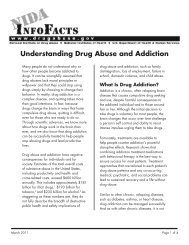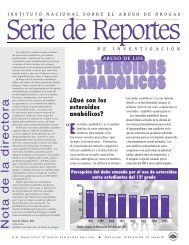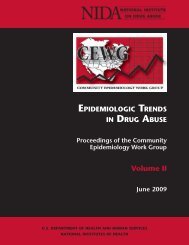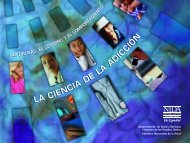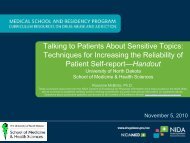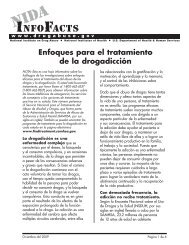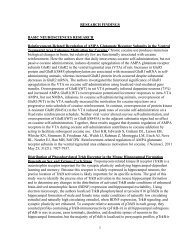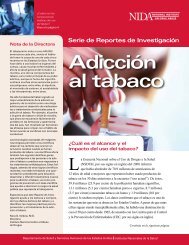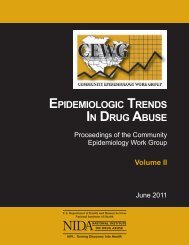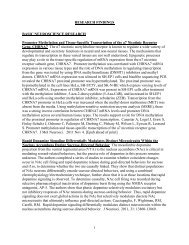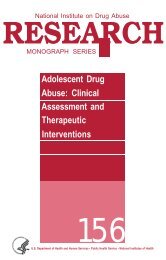CEWG January 09 Full Report - National Institute on Drug Abuse
CEWG January 09 Full Report - National Institute on Drug Abuse
CEWG January 09 Full Report - National Institute on Drug Abuse
You also want an ePaper? Increase the reach of your titles
YUMPU automatically turns print PDFs into web optimized ePapers that Google loves.
Secti<strong>on</strong> II. Highlights and Summary of Key Findings and Emerging <strong>Drug</strong> Issues From the <str<strong>on</strong>g>January</str<strong>on</strong>g> <str<strong>on</strong>g>CEWG</str<strong>on</strong>g> Meeting<br />
is returning in popularity in that area, where psychedelic<br />
mushrooms c<strong>on</strong>tinue to be used.<br />
PCP (Phencyclidine)<br />
• PCP persisted <strong>on</strong> the drug scene in several<br />
<str<strong>on</strong>g>CEWG</str<strong>on</strong>g> areas east of the Mississippi (St. Louis,<br />
Washingt<strong>on</strong>, DC, Philadelphia, New York City,<br />
Miami, and Chicago) and two in the West (Los<br />
Angeles and Texas).<br />
• The Philadelphia area representative reported<br />
that urinalysis results from the Adult Probati<strong>on</strong><br />
and Parole Department testing program have<br />
shown a gradual increase in the proporti<strong>on</strong> of<br />
adult probati<strong>on</strong>ers and parolees testing positive<br />
for PCP, from 8 percent in 2005 to 12 percent in<br />
CY 2008. PCP deaths decreased, and treatment<br />
admissi<strong>on</strong>s were stable in the first half of 2008<br />
in Philadelphia, compared with 2007. However,<br />
female treatment admissi<strong>on</strong>s, as a proporti<strong>on</strong> of<br />
total PCP treatment admissi<strong>on</strong>s, have increased,<br />
from 14 percent in 2005 to 29 percent in the first<br />
half of 2008.<br />
• In Washingt<strong>on</strong>, DC, in the first 10 m<strong>on</strong>ths of<br />
2008, approximately 10 percent of arrestees<br />
tested positive for PCP, compared with approximately<br />
9 percent each in 2006 and 2007, and 8<br />
percent in 2005, based <strong>on</strong> data from the District<br />
of Columbia Pretrial Services Agency. The<br />
percentage of juveniles testing positive for PCP<br />
remained stable at approximately 3 percent,<br />
from 2005 through the first 10 m<strong>on</strong>ths of 2008.<br />
The Los Angeles area, however, did not show an<br />
increase in PCP indicators during the reporting<br />
period.<br />
• In Washingt<strong>on</strong>, DC, PCP ranked fourth as the<br />
most frequently identified drug item in forensic<br />
laboratories in the first half of 2008 (table 1).<br />
• PCP was also am<strong>on</strong>g the top drug items identified<br />
in Philadelphia, where it ranked sixth, and<br />
New York City, where it ranked fifth.<br />
• No PCP items were documented am<strong>on</strong>g the<br />
forensic laboratory data <strong>on</strong> drug items identified<br />
in eight <str<strong>on</strong>g>CEWG</str<strong>on</strong>g> areas (Albuquerque,<br />
Atlanta, Cincinnati, Denver, Detroit, H<strong>on</strong>olulu,<br />
Miami, and Minneapolis/St. Paul), and fewer<br />
than 30 such items were identified in seven<br />
areas (Baltimore City, Bost<strong>on</strong>, Phoenix, San<br />
Diego, San Francisco, Seattle, and St. Louis).<br />
The areas reporting 30 or more PCP items were<br />
Chicago, Los Angeles, New York City, Philadelphia,<br />
Maryland, Texas, and Washingt<strong>on</strong>, DC.<br />
(secti<strong>on</strong> IV, table 12).<br />
• PCP figured am<strong>on</strong>g the top 10 most frequently<br />
identified drug items in seven <str<strong>on</strong>g>CEWG</str<strong>on</strong>g> areas<br />
from NFLIS data for the first half of 2008.<br />
Besides Washingt<strong>on</strong>, DC, New York City, and<br />
Philadelphia, where PCP ranked 4th, 5th, and<br />
6th, respectively, in NFLIS drug items identified<br />
in 1H 2008, PCP ranked 7th in Los Angeles,<br />
and 10th each in Maryland, Chicago, and Texas<br />
(table 1). As a percentage of all identified items,<br />
PCP items were highest in Washingt<strong>on</strong>, DC, at<br />
5.6 percent, followed by Philadelphia, at 2.7 percent,<br />
and New York City, at 1.5 percent (secti<strong>on</strong><br />
IV, table 13; appendix table 2).<br />
Other <strong>Drug</strong>s and <strong>Drug</strong> <strong>Abuse</strong><br />
Patterns/Issues<br />
• BZP (1-benzylpiperazine) 1 : Findings from the<br />
<str<strong>on</strong>g>January</str<strong>on</strong>g> 20<str<strong>on</strong>g>09</str<strong>on</strong>g> <str<strong>on</strong>g>CEWG</str<strong>on</strong>g> meeting suggest that BZP<br />
may be emerging as a drug of c<strong>on</strong>cern. BZP is<br />
a synthetic stimulant, usually c<strong>on</strong>sumed orally,<br />
but sometimes smoked or snorted. BZP is illegal,<br />
has no accepted medical use in the United<br />
States, and has been c<strong>on</strong>trolled as a Schedule<br />
I substance since 2004 under the C<strong>on</strong>trolled<br />
Substance Act. The representative from Seattle<br />
1<br />
More informati<strong>on</strong> <strong>on</strong> BZP can be found at: http://www.deadiversi<strong>on</strong>.usdoj.gov/drugs_c<strong>on</strong>cern/bzp_tmp/bzp_tmp.htm.<br />
Proceedings of the Community Epidemiology Work Group, <str<strong>on</strong>g>January</str<strong>on</strong>g> 20<str<strong>on</strong>g>09</str<strong>on</strong>g> 21



